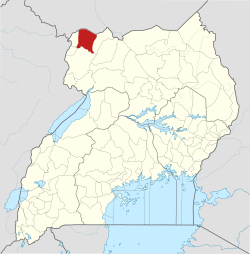| Abiriamajo Primary School |
| Achilaka Primary School |
| Acholi Primary School |
| Adranga Primary School |
| Agonga Primary School |
| Akande primary School |
| Akia Primary School |
| Alaba Islamic Primary School |
| Alaba Primary School |
| Aliapi Primary School |
| Aliba Primary School |
| Alinga Primary School |
| Alligo Primary School |
| Amaguru Primary School |
| Ambiya Primary School |
| Anshwari Primary School |
| Ariju Model Primary School |
| Aringa Islamic Primary School |
| Ariwa Primary School |
| Awinga Primary School |
| Awoba Primary School |
| Ayago Primary School |
| Ayivu Primary School |
| Ayivu Ref Settlement Primary School |
| Banika Islamic Primary School |
| Barakala Primary School |
| Bilijia Primary School |
| Binagoro Primary School |
| Christ The King Primary School Ariwa |
| Dondi Primary School |
| Dracia Hill Islamic Primary School |
| Dradranga Islamic primary School |
| Dramba P.7 School |
| East Alipi Primary School |
| East Koka Primary School |
| Eleke Primary School |
| Fataha Primary School |
| Galaba P.7 School |
| Geya Primary School |
| Gichara Primary School |
| Goboro Primary School |
| Gojuru Primary School |
| Govule Islamic Primary School |
| Highland Primary School |
| Hilalitopio Primary School |
| Hillttop Primary School Limu |
| Hope Primary School |
| Imvenga Primary School |
| Inia Primary School |
| Iyete Primary School |
| Jalata Primary School |
| Kado Primary School |
| Kanabu Hill Primary School |
| Kechuru Primary School |
| Kejebere Primary School |
| Kenga Valley Primary School |
| Kenyanga Primary School |
| Kerwa Primary School |
| Keyi P.7 School |
| Kilaji Primary School |
| Kisimunga Primary School |
| Knowledge Land Primary School |
| Kochi Bridge Primary School |
| Kodejje Primary School |
| Koka Primary School |
| Komgbe Primary School |
| Koro Highland Primary School |
| Kubali Primary School |
| Kulikulinga Islamic primary School |
| Kulinga Primary School |
| Kululu Primary School |
| Kumia Primary School |
| Kumuna Primary School |
| Kuru Islamic Primary School |
| Kuru Primary School |
| Lamgba Primary School |
| Langi Primary School |
| Legu primary School |
| Limidia Primary School |
| Lobe P.7 School |
| Locomgbo Primary School |
| Lodenga Primary School |
| Lodonga Black Primary School |
| Lodonga Demo. School |
| Lodonga Girls’ Primary School |
| Logoa Primary School |
| Lokopio Primary School |
| Lombe Primary School |
| Lomorojo Primary School |
| Lomunga Primary School |
| Lukutua Primary School |
| Luzira Bright View Primary School |
| Manibe Islamic Primary School |
| Matu Primary School |
| Matuma Primary School |
| Mengo Primary School |
| Menzere Primary School |
| Mgbilinji Primary School |
| Midigo Calvary Primary School |
| Midigo Primary School |
| Mijale Primary School |
| Mijikita Primary School |
| Moli Primary School |
| Molondo Bright Primary School |
| Mongoyo Primary School |
| Mulumbe Primary School |
| Munir Primary School |
| Naku Primary School |
| Nipata Valley Primary School |
| Nyoko Kobo Primary School |
| Nyoko Primary School |
| Nyori P.7 School |
| Obero Primary School |
| Obero West Primary School |
| Odravu Primary School |
| Odropi Primary School |
| Ofonze Primary School |
| Ojinga Primary School |
| Okoi Primary School |
| Okuvuru Primary School |
| Okuyo Primary School |
| Olivu primary School |
| Oluba Primary School |
| Omba Primary School |
| Ombechi Primary School |
| Ombetiku Cope |
| Omgbokolo Primary School |
| Oniku P.7 School |
| Oria Primary School |
| Osubira Village Primary School |
| Paduru Primary School |
| Pajama P.7 School |
| Pakayo Primary School |
| Para Primary School |
| Peace Primary School |
| Rembeta Primary School |
| Rimbe Primary School |
| Rock City Primary School |
| Rockland Primary School |
| Salam Primary School |
| St. Catherine Primary School |
| St. Daniel Comboni Primary School |
| Swinga Primary School |
| Takwa Primary School |
| Tokuro Primary School |
| Tuliki Primary School |
| Twajiji Hope Primary School |
| Twajiji Primary School |
| Universal Primary School |
| Urungu Primary School |
| Wetikoro Primary School |
| Wolo Primary School |
| Yangani Progrssive Primary School |
| Yiba Parents Primary School |
| Yoyo Central Primary School |
| Yoyo Primary School |
| Yumbe Calvary Primary School |
| Yumbe Primary School |

